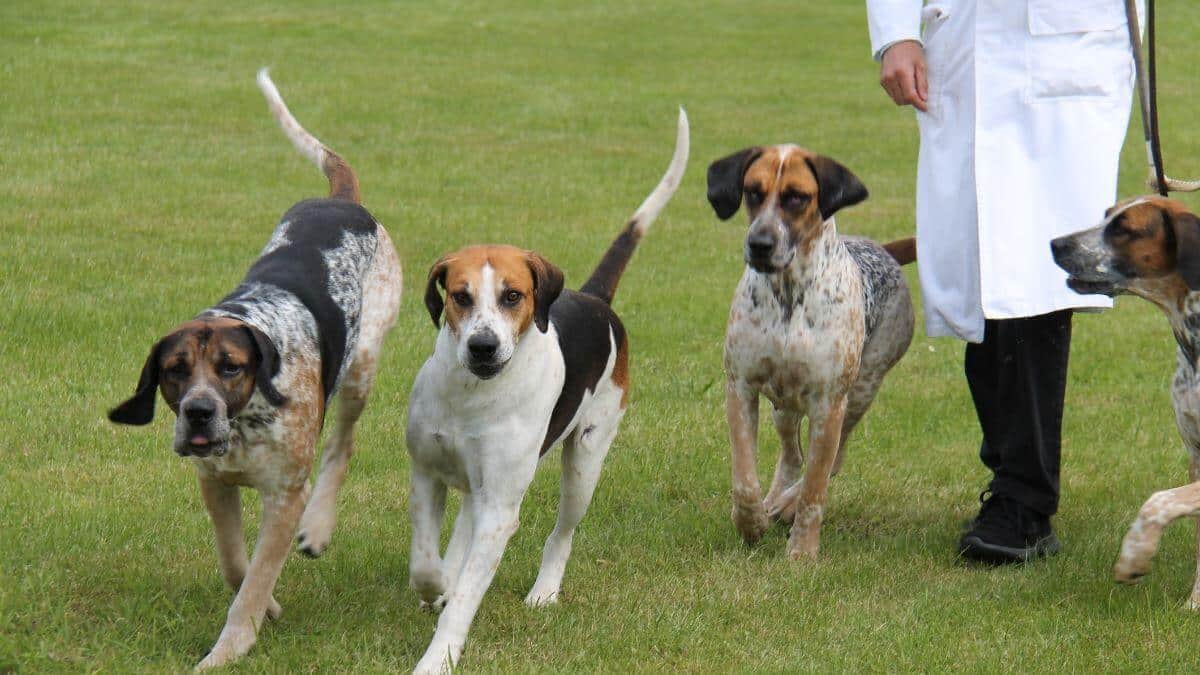


Home » Temperament in the English Foxhound

This article was originally published in Showsight Magazine, February 2011 issue.
The English Foxhound, relatively unknown to the general public, nearly always ranks last in numbers registered by AKC. These hounds, primarily kept as hunting dogs by organized packs, exist as they have been for hundreds of years.
The disposition of the breed reflects the purpose for which it was perfected: to hunt the fox as a pack. The emphasis is on working well with other hounds rather than socializing extensively or being handled by multiple humans. Their traditional setting is the fields, farms, and kennels, rather than large dog show halls or suburban family homes.
As the breed becomes more popular as family pets, show dogs, and performance event competitors, the origins of the breed must be taken into account in each facet of the breed’s evolution.
When families inquire about an English Foxhound as a companion dog, a frequent concern is the lifestyle and environment the hound would live in. Suburban neighborhoods with covenants restricting traditional fences conflict with keeping an English Foxhound safe and secure.
“Invisible” fences are no match for a hunting hound’s desire to follow his nose. A successful hunter must have the drive and determination to follow his quarry over, under, around, and through any obstacle in his path. His instincts cannot distinguish a family picket fence from the barriers his ancestors overcame in pursuit of foxes.
To keep a foxhound as a family pet, owners must be dedicated to providing adequate exercise in a secure environment and never allowing the hound off-leash unsupervised.
When considering an English Foxhound as a show dog, exhibitors must understand this breed was never intended to be a “show dog.” Instinct places the highly evolved nose on the ground for scenting, not carried in the air for a desired show ring carriage.
The breed’s keen hearing may be insulted by the boom of loudspeakers or the roar of a motor home generator. As a hunting hound, they are rarely handled by strangers and are typically cared for by a single huntsman in the kennel and field.
Traits such as acceptance of strangers and outgoing behavior in all situations have not been widely selected for in the breed’s development. This contrasts with AKC show ring procedures, which differ greatly from the methods used by Masters of Foxhound judges.
In hound shows, English Foxhounds are evaluated off-lead in a fenced enclosure, standing while being baited by their familiar huntsman and staff. They are never hand-stacked, and judges rarely put hands on the hounds. In such settings, it is rare to see shyness or resentment.
However, in traditional AKC shows, much socialization and patience are often required to produce desired results. A few exceptional dual-purpose hounds have successfully bridged the gap, becoming top show dogs and valued pack members.
These dispositions need to be included in the gene pool if the breed is to evolve into a truly dual-purpose breed.
If called upon to judge English Foxhounds, the judge should remember the purpose and origins of the breed, selecting not only for the desired structure but also the correct temperament of a pack hunter.
Aggression toward other dogs or humans cannot be tolerated. Young entries may not move with their noses off the ground and should not be forced into an unnatural gait. A good judge can evaluate a hound without excessive handling or noise. Quiet observation produces a more relaxed hound, whereas rattling keys or squeaking toys may evoke only a startled expression.
English Foxhound breeders must continually strive to improve temperament and incorporate desired traits into future generations. Despite a limited gene pool, this must remain a priority if the breed is to thrive in all facets of purebred dog activities.